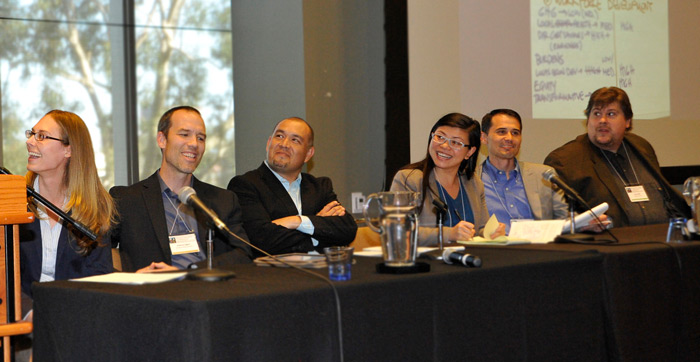Evaluating Process, Progress and Results
The Transformative Climate Communities Program (TCC) may be the most innovative, comprehensive, and equitable experiment in community-scale climate action, ever. It empowers underinvested communities to choose and implement their vision, strategies, and projects – all with data-driven milestones and measurable outcomes. LCI is documenting the groundbreaking progress of TCC-supported action in five cities: Fresno, Ontario, Stockton, and the Watts and Northeast San Fernando Valley neighborhoods of Los Angeles. TCC projects including clean transportation, affordable housing, renewable energy, energy efficiency, urban greening, and more are benefiting communities profoundly, providing savings on energy and rent, greener streets, job training, and more.
The nonprofit organization Valley Clean Air Now (Valley CAN) operates multiple longstanding clean vehicle programs to reduce emissions from older vehicles in the San Joaquin Valley (SJV) of California, a region with many disadvantaged communities with environmental justice concerns. Since 2015, Valley CAN has piloted and now operates the Clean Cars 4 All program (also known as Drive Clean in the San Joaquin), which offers clean vehicle incentives to low- to moderate-income households.
This evaluation by LCI utilizes several datasets to track program progress over the nine-month period of October 2018 through June 2019, a time when Electrify America provided enhanced funding for Valley CAN to accelerate the reach and pace of the program in the SJV. This initial assessment considers four stages of impact experienced by SJV residents via the enhanced funding: awareness, involvement, engagement, and vehicle acquisition. Even in this short period, we observe notable positive impacts.
LCI completed the first-ever study of the statewide employment outcomes from California Climate Investments. See the article in Capitol Weekly. We found that for every $1 million the state spends in California Climate Investments, 8.8 jobs are supported in California. This can be compared to 1.6 jobs for every $1 million invested in the oil and gas industries.
Informed by research from LCI, the California Air Resources Board (CARB) introduced the Enhanced Fleet Modernization Program (EFMP) Plus-Up pilot program to better integrate vehicle retirement and replacement incentive programs in support of low- to moderate-income households. LCI researchers then studied how the EFMP Plus-Up pilot was implemented. This report describes lessons learned from the first year of operation in the San Joaquin Valley Air Pollution Control District and South Coast Air Quality Management District. LCI’s analysis supported a geographic expansion of this program, now called Clean Cars 4 All.
More Californians can now afford clean vehicles, in part thanks to research involving the LCI. The researchers assessed the performance of alternative rebate designs for PEVs and compared these alternatives in terms of cost-effectiveness and equity. They found that providing progressive rebate levels based on consumer income levels would provide benefits within those performance criteria. These findings helped inform the adoption of California’s progressive rebate system in which low- and moderate-income drivers receive an additional $3,000 to $6,500 in financial incentives to purchase a clean vehicle. Additionally, income rules for most rebates limit eligibility to households with less than $500,000 in annual income.
Informing Equitable and Effective Investments
President Biden’s Justice40 Initiative aims to “address the disproportionate health, environmental, economic and climate impacts on disadvantaged communities.” This report provides a framework that federal officials could use to maximize Justice40’s impact. Drawing from analysis of state-level climate programs seeking to address environmental justice, the authors identify key areas of focus for the initiative: investing to provide resources for the people who need them most, empowering communities to make local policy and investment decisions, and holding government agencies and contractors accountable for furthering environmental justice goals.
State proceeds from California’s carbon Cap-and-Trade Program flow into the Greenhouse Gas Reduction Fund (GGRF) and then are appropriated by the Legislature as California Climate Investments. This report provides a guide to California Climate Investments, focusing on programs most targeted to benefit disadvantaged communities. The report provides an overview of each program and then analyzes program investments based on recent funding levels (inputs) before and after the GGRF. Additionally, the authors put forth a framework to systematically assess program inputs, outputs, outcomes, and impacts. They also make recommendations to enhance benefits from the investments.
Senate Bill 535 (de León), signed into law in 2012, requires that 25 percent of proceeds in the Greenhouse Gas Reduction Fund go to projects (now referred to as California Climate Investments) that provide benefits to disadvantaged communities in California. LCI organized a working summit (see below) and as an outcome produced a report that proposes a framework for planning and implementing California Climate Investments to help maximize benefits in communities affected by pollution and poverty.

Government agency and climate equity leaders speak at an Investment Justice Workshop hosted by LCI.
Climate Equity Workshops (2014 and 2015)
Lead organizer: Colleen Callahan, with collaborators
In 2014, LCI hosted the first major statewide gathering to inform implementation of California Climate Investments in disadvantaged communities. Nearly 200 government leaders, climate equity advocates, researchers, and executives of nonprofits and business associations participated in the working summit, which involved providing advice in investment sector specific breakout groups. Afterward, LCI co-hosted or participated in Los Angeles region and statewide climate equity convenings in collaboration with the California Climate Equity Coalition.


